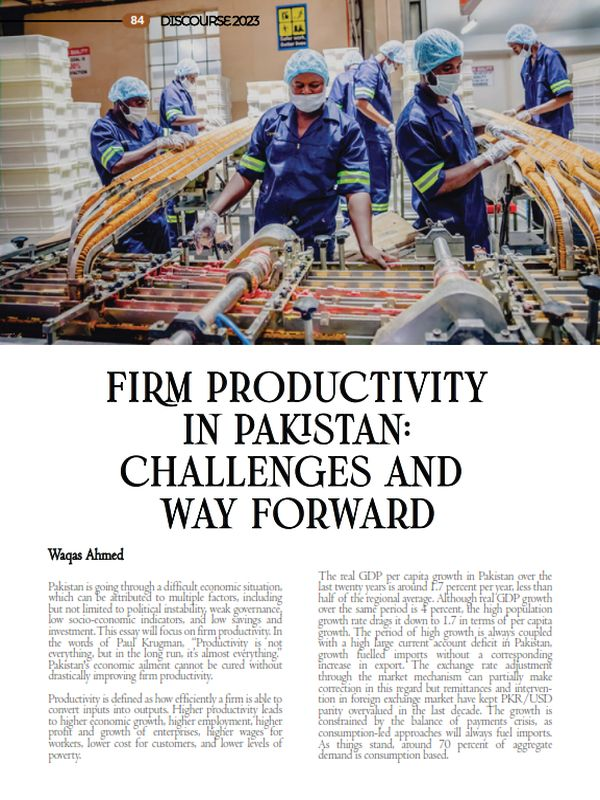Firm Productivity in Pakistan: Challenges and Way Forward
Pakistan is going through a difficult economic situation, which can be attributed to multiple factors, including but not limited to political instability, weak governance, low socio-economic indicators, and low savings and investment. This essay will focus on firm productivity. In the words of Paul Krugman, “Productivity is not everything, but in the long run, it’s almost everything.” Pakistan’s economic ailment cannot be cured without drastically improving firm productivity.
Productivity is defined as how efficiently a firm is able to convert inputs into outputs. Higher productivity leads to higher economic growth, higher employment, higher profit and growth of enterprises, higher wages for workers, lower cost for customers, and lower levels of poverty.
The real GDP per capita growth in Pakistan over the last twenty years is around 1.7 percent per year, less than half of the regional average. Although real GDP growth over the same period is 4 percent, the high population growth rate drags it down to 1.7 in terms of per capita growth. The period of high growth is always coupled with a high large current account deficit in Pakistan, growth fuelled imports without a corresponding increase in export. The exchange rate adjustment through the market mechanism can partially make correction in this regard but remittances and intervention in foreign exchange market have kept PKR/USD parity overvalued in the last decade. The growth is constrained by the balance of payments crisis, as consumption-led approaches will always fuel imports. As things stand, around 70 percent of aggregate demand is consumption based.
Low productivity of agriculture has implications for structural transformation as more labour is locked in agriculture with low value added. In the past two decades, employment in agriculture has decreased by 10 percent. During the same period, labour share increased by 5 percent in manufacturing, 3 percent in services, and 2 percent in non-manufacturing industries. This reallocation of labour from agriculture to other sectors of the economy has not improved the productivity of these sectors. The labour productivity in manufacturing and services is only 30 percent and 150 percent of labour productivity in agriculture despite the low base of productivity in agriculture. The growth of value added per worker in manufacturing is 0.9 percent per year and 1.3 percent in the services sector over the last two decades for Pakistan. This is much lower than other comparable countries where these growth rates are 2.5 and 1.9 percent respectively.
These numbers paint a dismal picture of productivity. The analysis of listed firms reveals a slow decline in the total factor productivity of these firms over the last decade. The increase in the age of firms is normally associated with better productivity. In the case of Pakistan, however, firms do not seem to become more productive as they age. A firm as old as 40 years is on average as productive as one that is 10 years old. This pattern suggests that due to a lack of technology adoption, firms are aging without improving their productivity. In the case of firm size, there is evidence that increase in size has a positive impact on productivity through economies of scale. The difference in management practices among firms can partially explain their productivity differential. Research by Bloom et. al (2019) documents the importance of management practices for better firm performance and attributes 20 percent of the variation in firm-level productivity to them.
The challenge of low productivity is multifaceted and requires improvement on many fronts. The productivity of a firm can substantially increase by integrating with the global value chain. Knowledge transfer and specialization through international trade can facilitate the convergence of productivity levels with the developed world. We need to remove distortions in the exchange rates and tax policies to facilitate more trade. In the last twenty years, export as a percentage of GDP has fallen from 16% in 1999 to only 10% in 2020. This illustrates the lack of competitiveness of local production and the downside of protective policies. Import duties to protect local manufacturers has actually functioned as a tax on export. There is almost a 50 percent increase in import duties on intermediates in the manufacturing sector, which restrict technology choices and adversely affect productivity. A firm operating in the international market needs to be more innovative and productive in order to stay competitive. The productivity of exporting firms is around 20 percent higher than firms focused on the domestic market. There is a virtuous cycle between export and productivity. The credit support policy for exporting firms is primarily focused on the financing of working capital management. The subsidised capital should be channelled towards long-term financing of investment and innovation that can improve productivity and export as well.
Management is the visible hand that can improve the efficiency and productivity of the firm. The funds from unconditional subsidies should be reallocated to cost-sharing management training programs to upgrade managerial capabilities at firms and ultimately improve their productivity.
Access to credit is another issue faced by firms in Pakistan, especially for Small and Medium Enterprises. Persistent fiscal deficit and government borrowing have a crowding-out effect on the private sector. Firms without access to credit cannot exploit growth and export opportunities. The investment in product or process innovation is also constrained by the non-availability of credit, leading to low productivity.
Firm productivity can be improved by removing distortions in resource allocation, improving access to credit, and professionalising the management of firms.
The author is an Assistant Professor, Faculty of Management Sciences at the International Islamic University, Islamabad. He can be reached via email at [email protected] and Twitter at @Waqas999.
References
Bloom, N., Brynjolfsson, E., Foster, L., Jarmin, R., Patnaik, M., Saporta-Eksten, I., & Van Reenen, J. (2019). What drives differences in management practices?. American Economic Review, 109(5), 1648-1683.
Raza, B. 2021. “Balance of Payments Constrained Growth in Pakistan-Implications for Development Policy.” State Bank of Pakistan, Research Department (No. 107).




